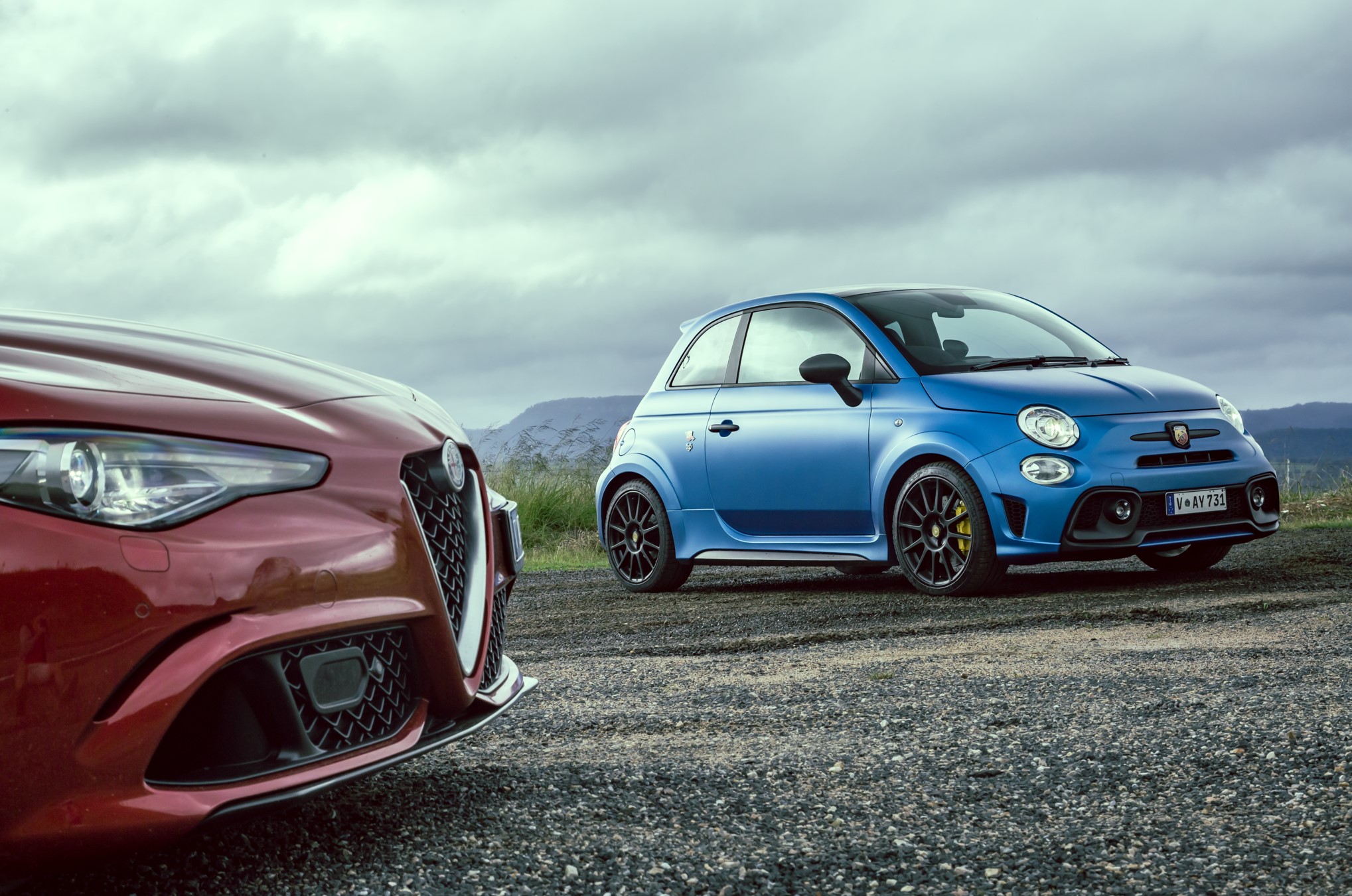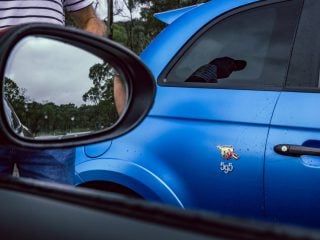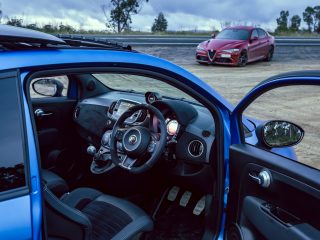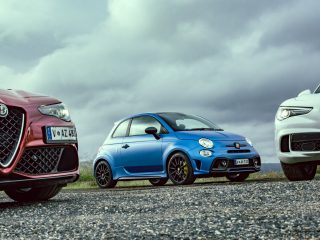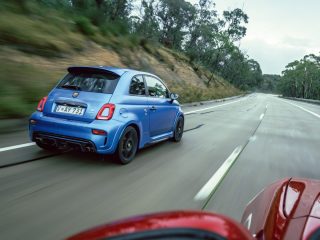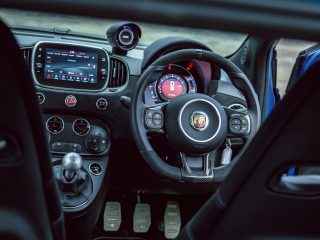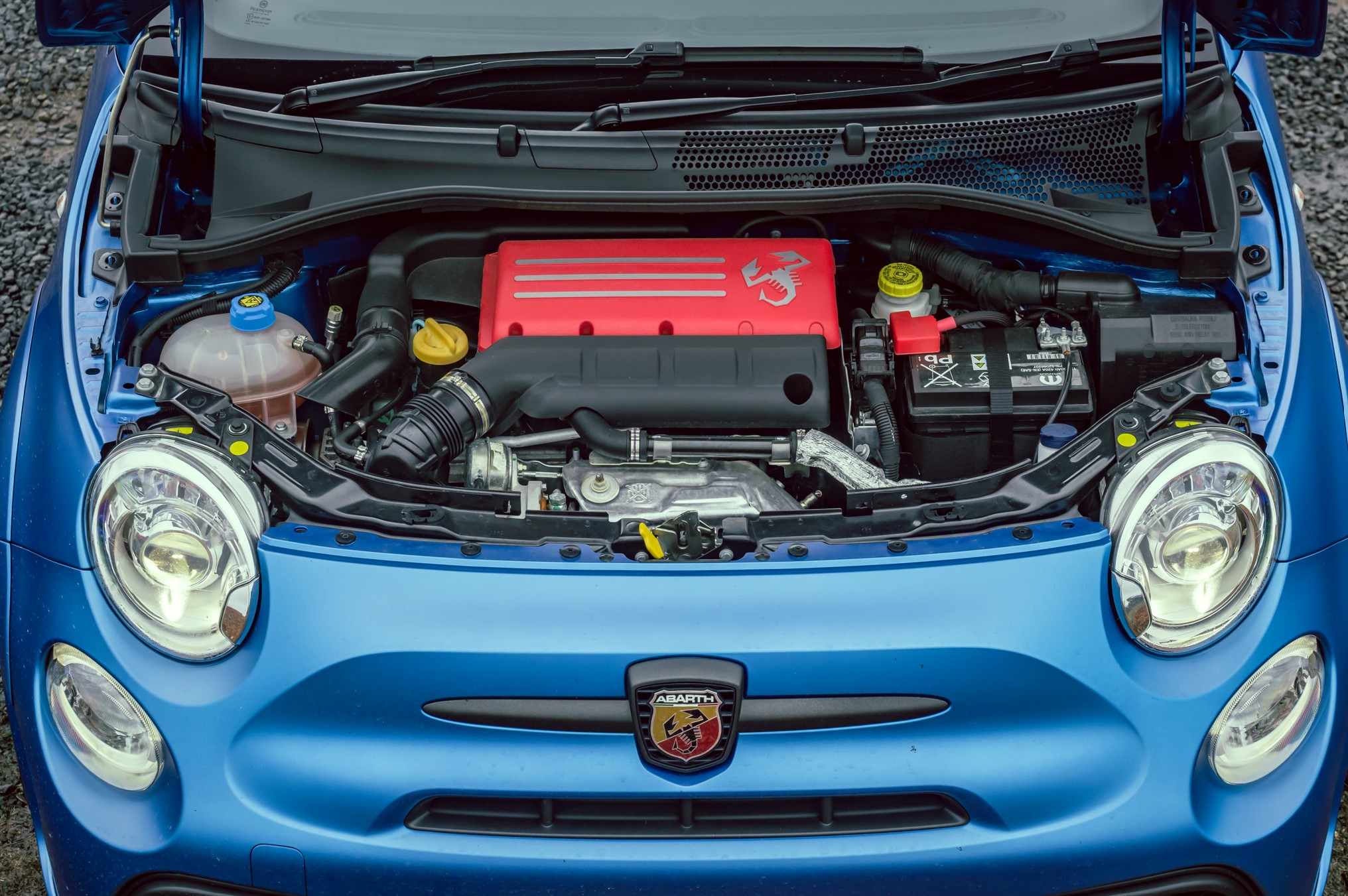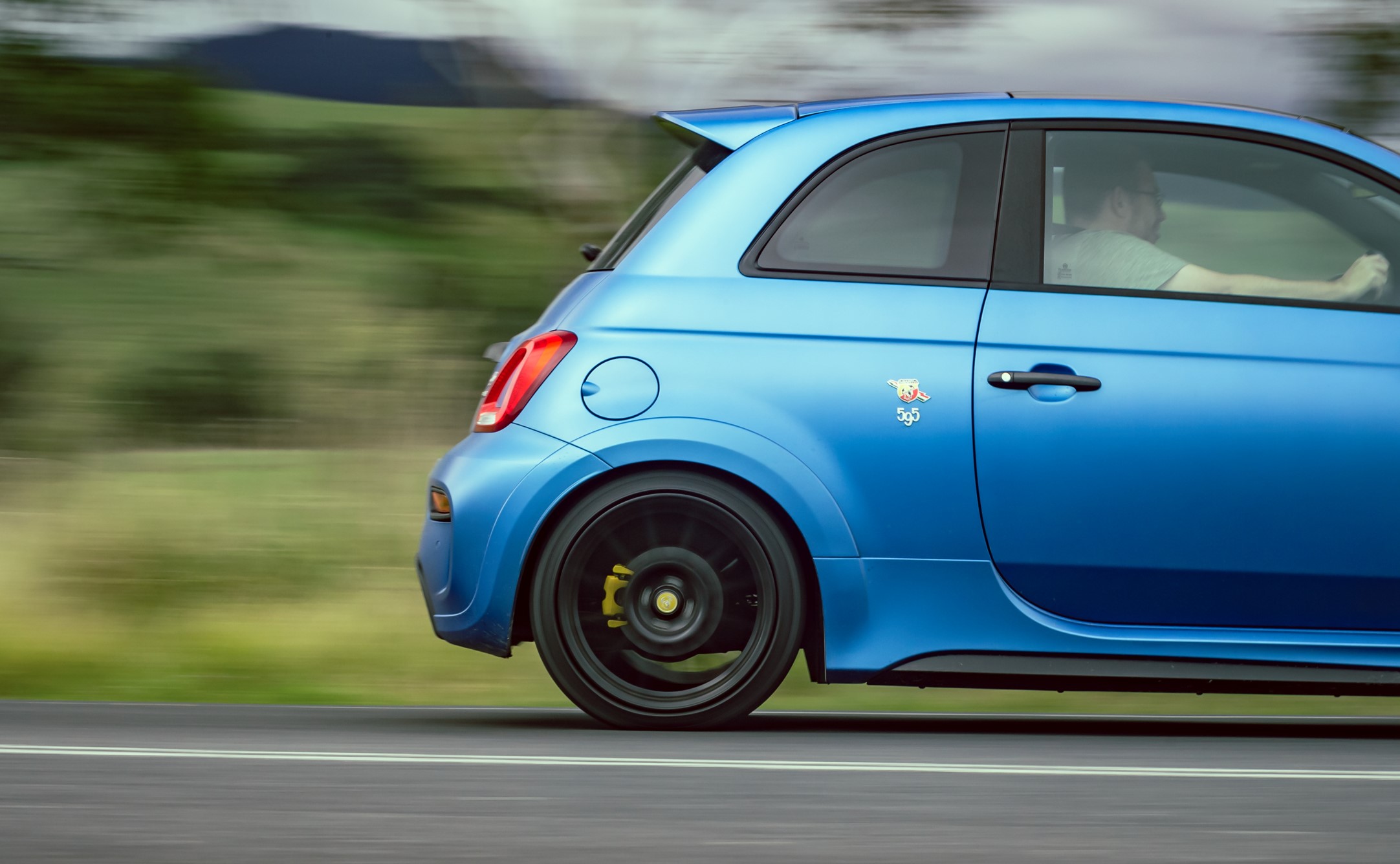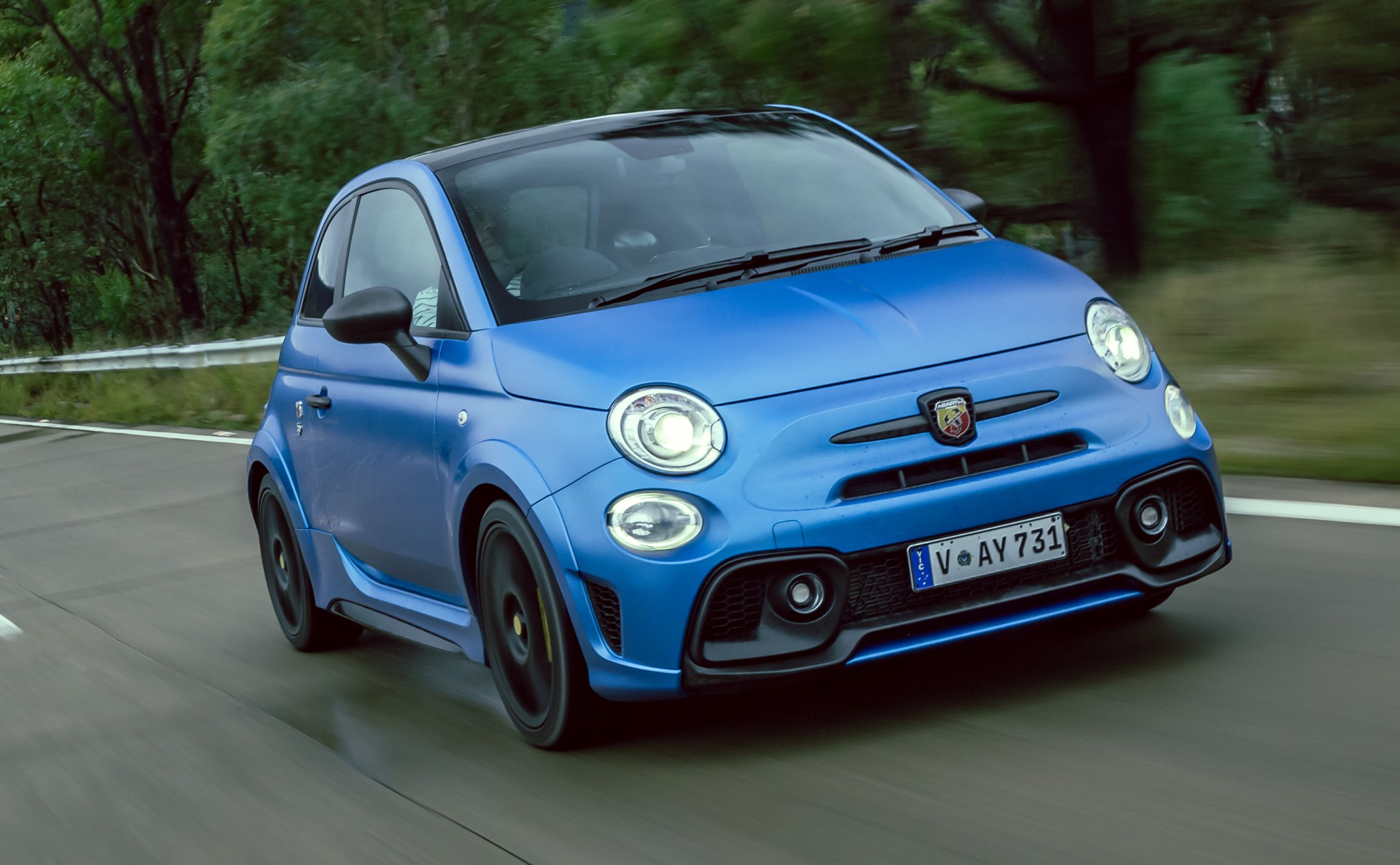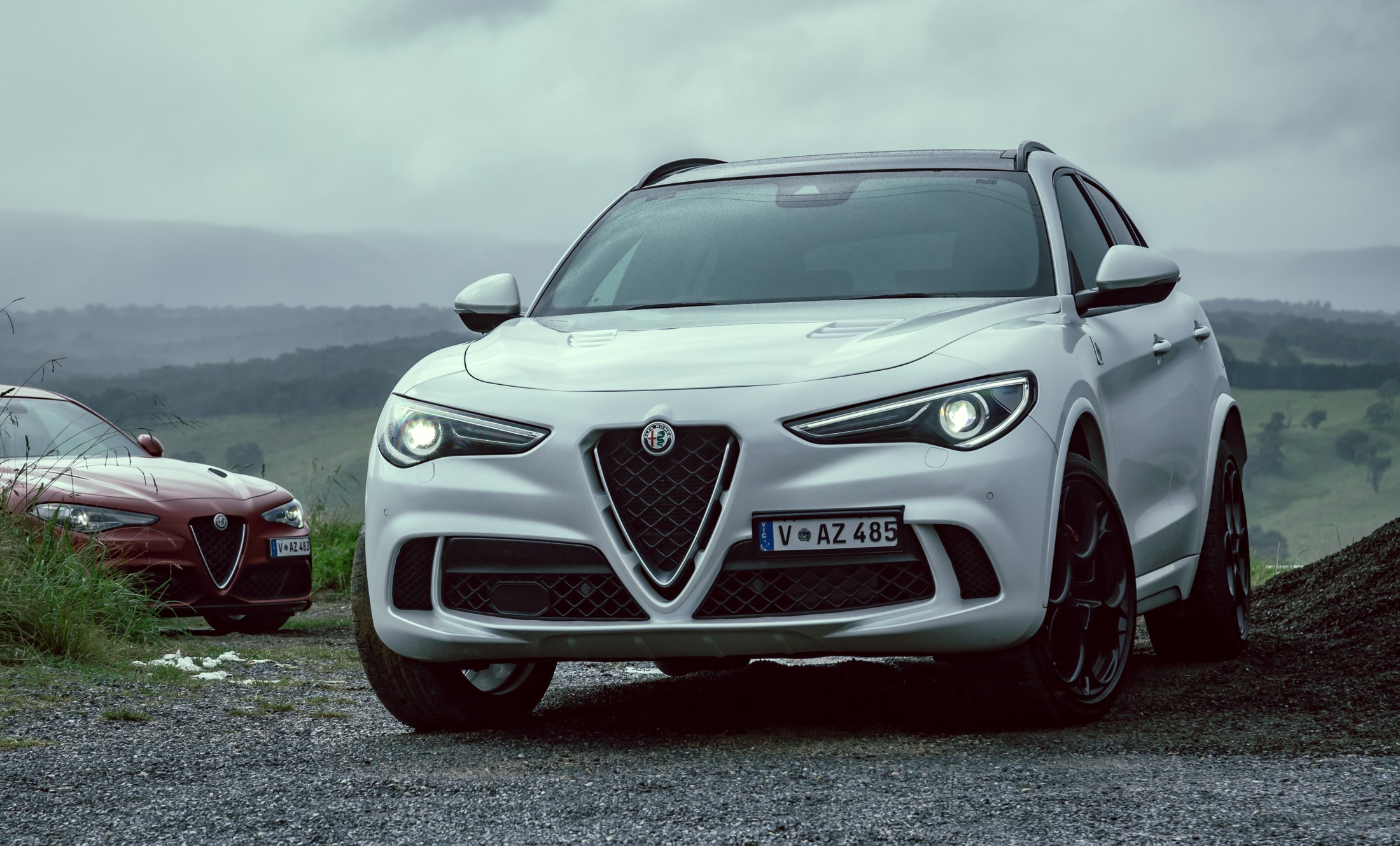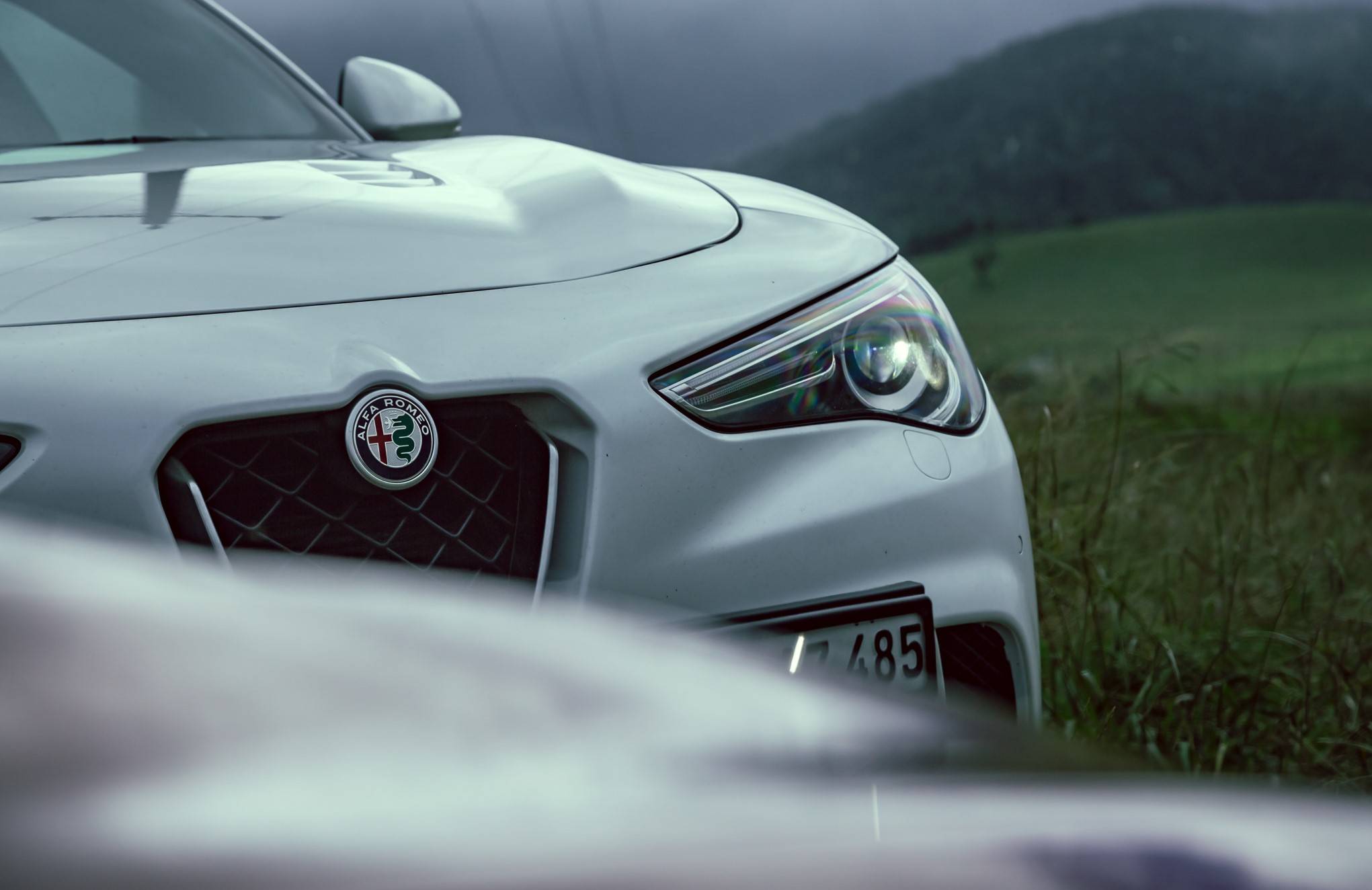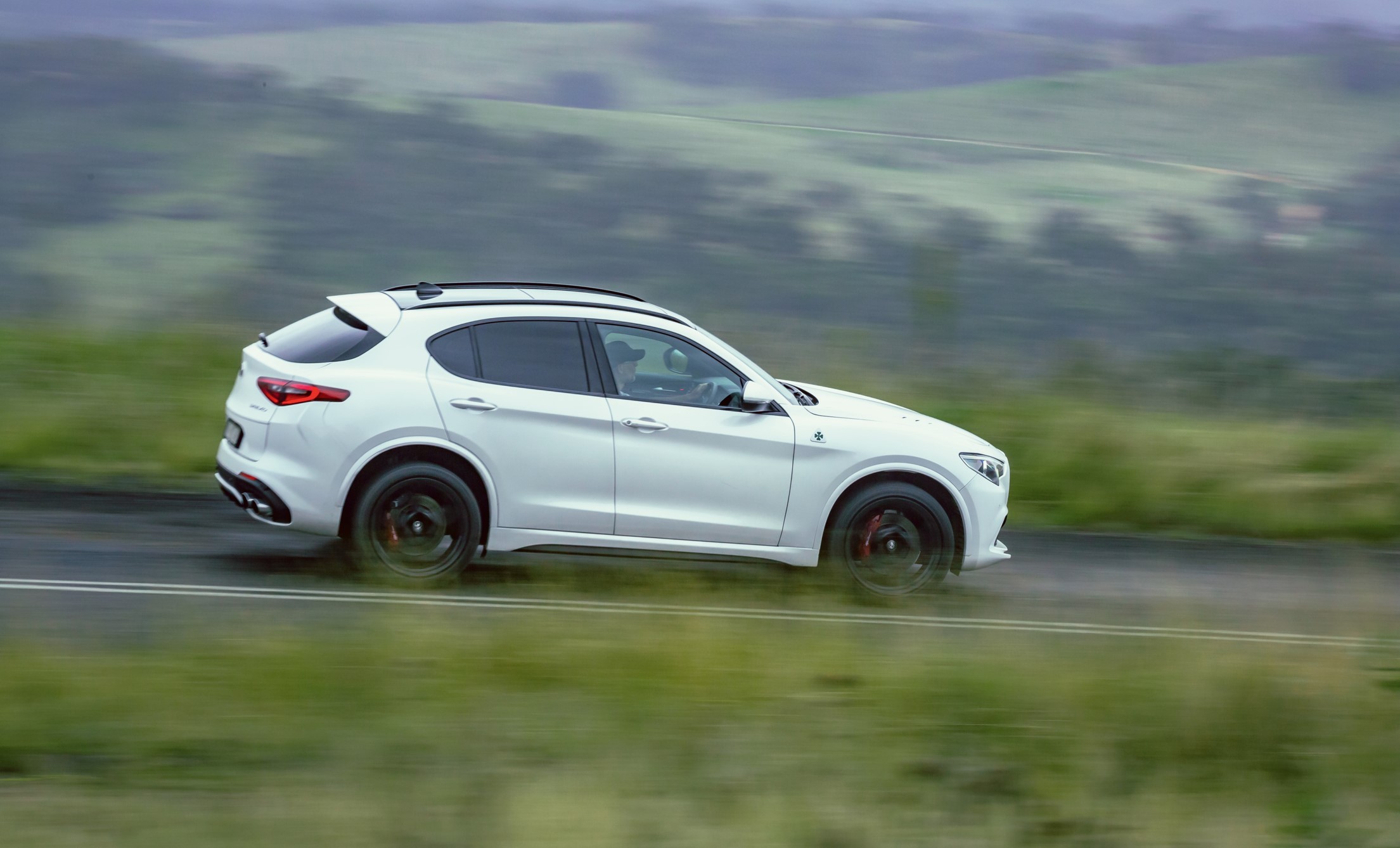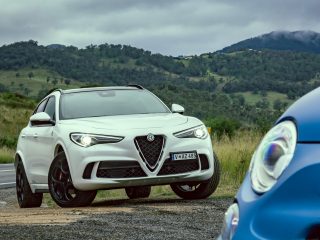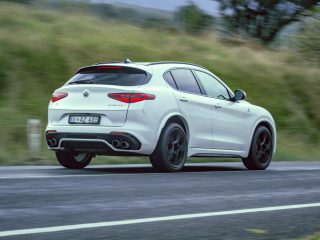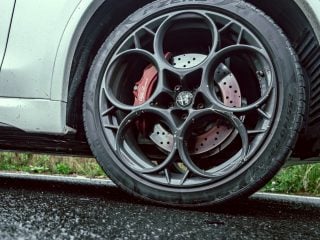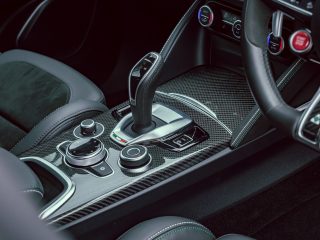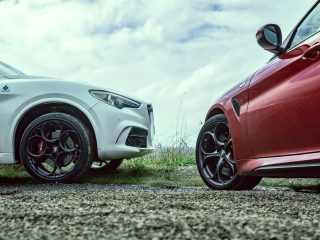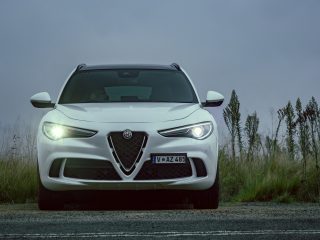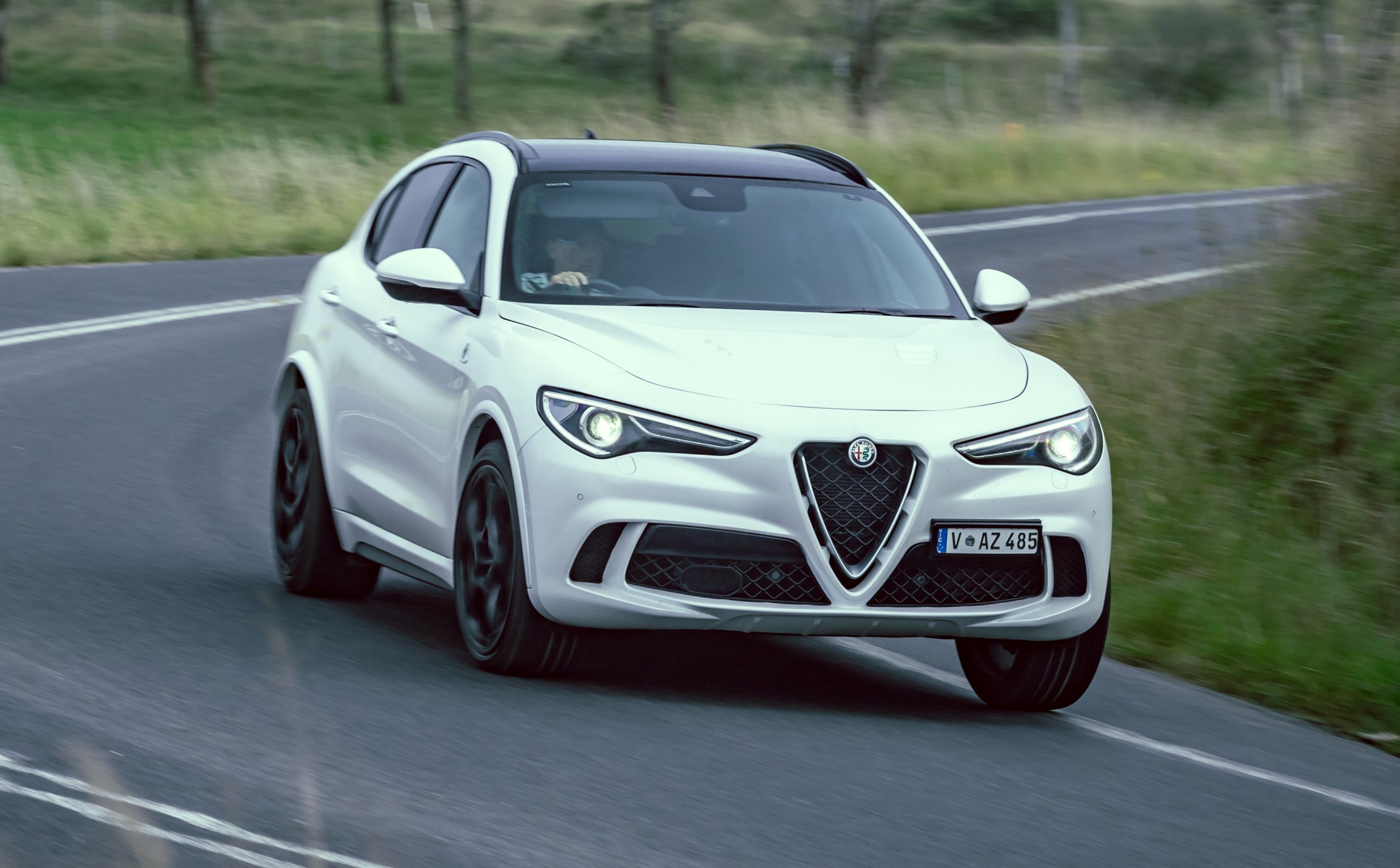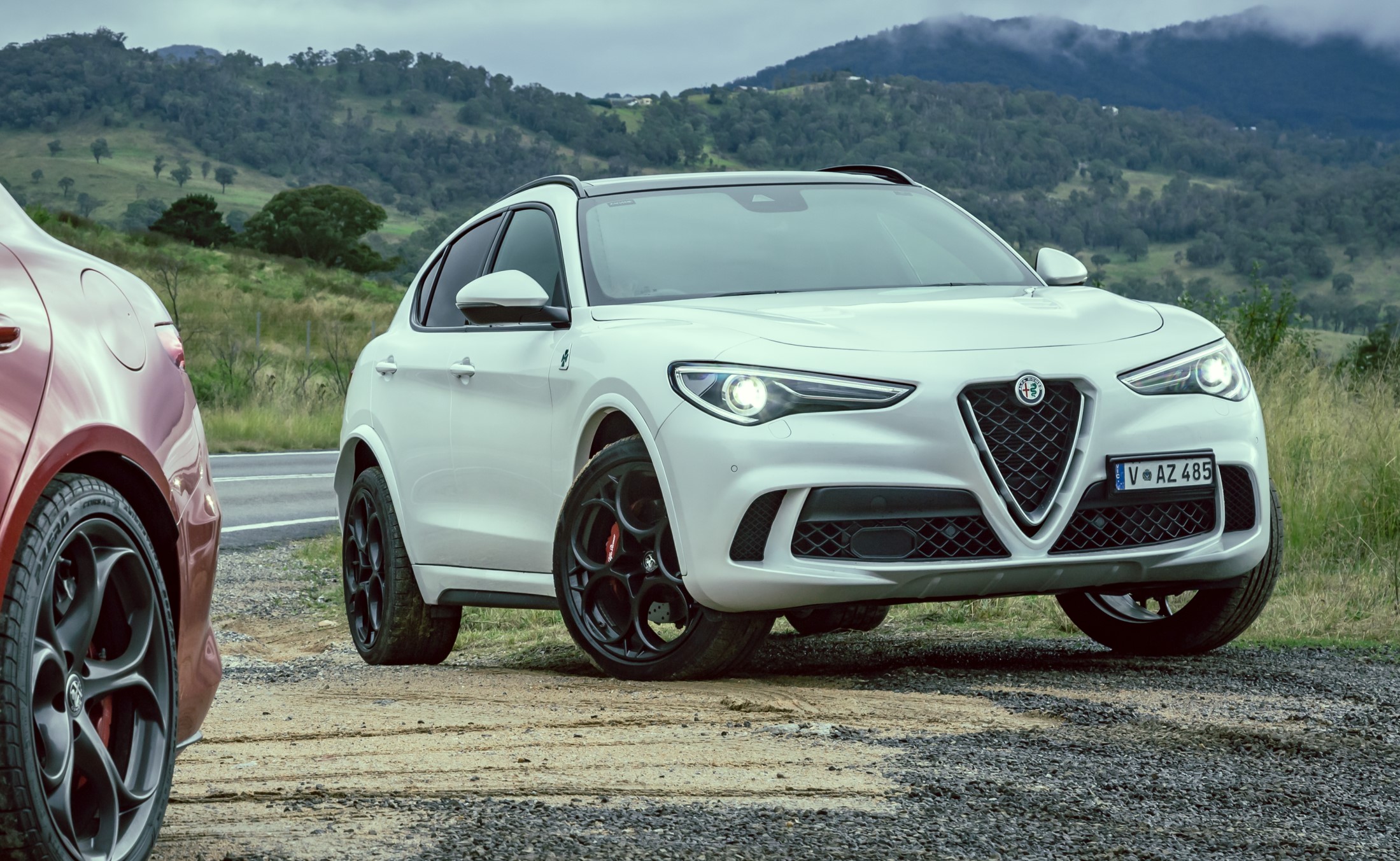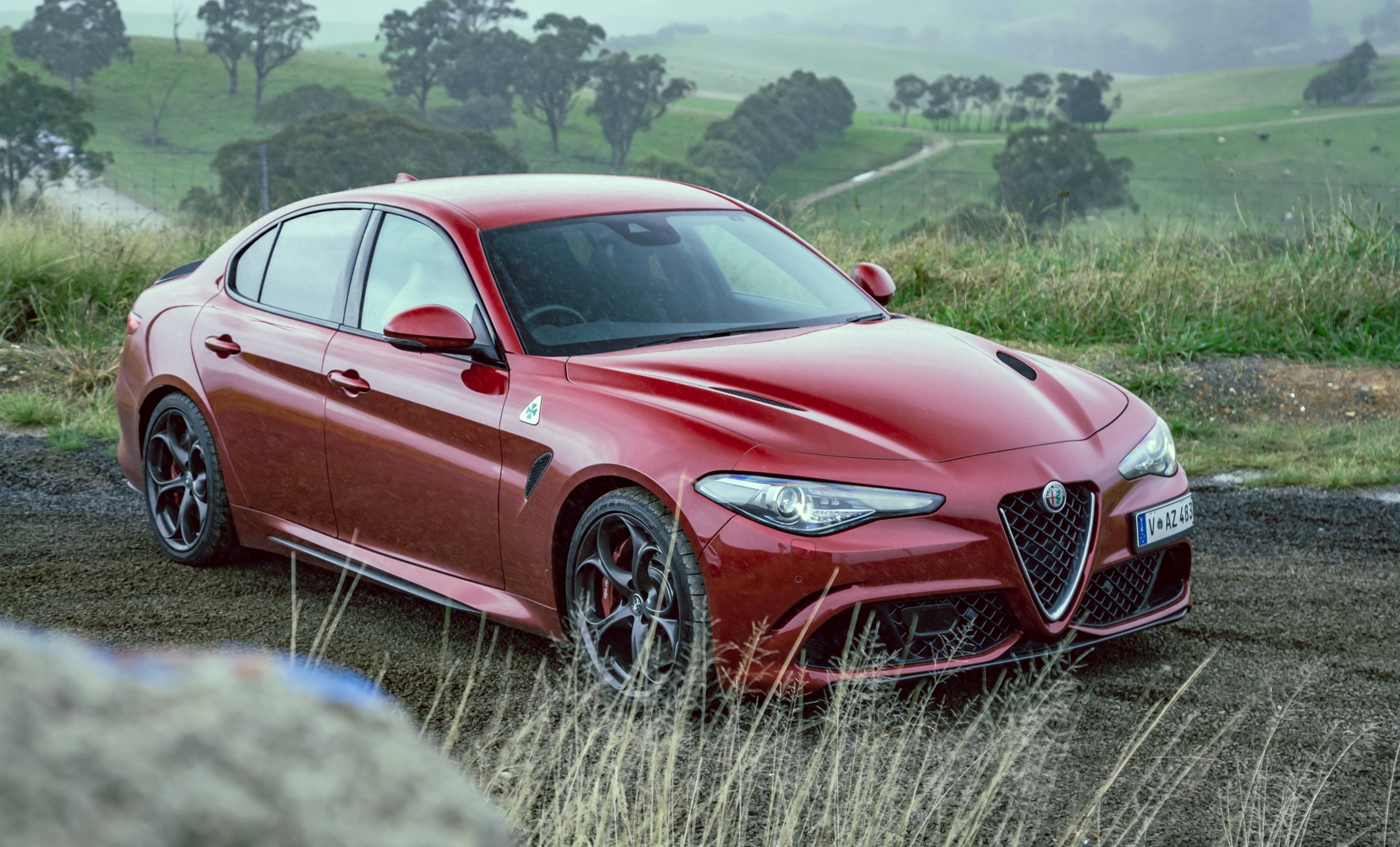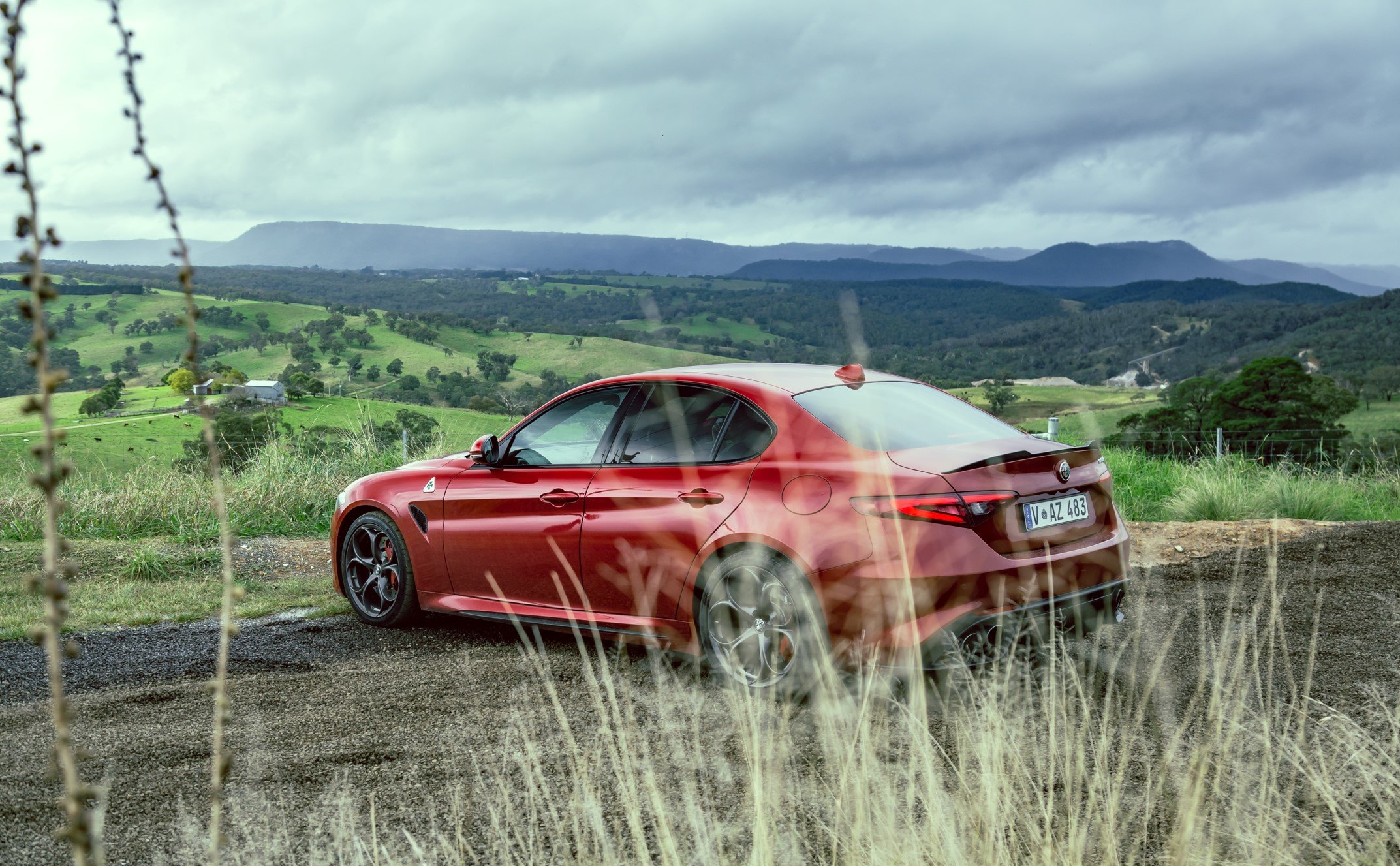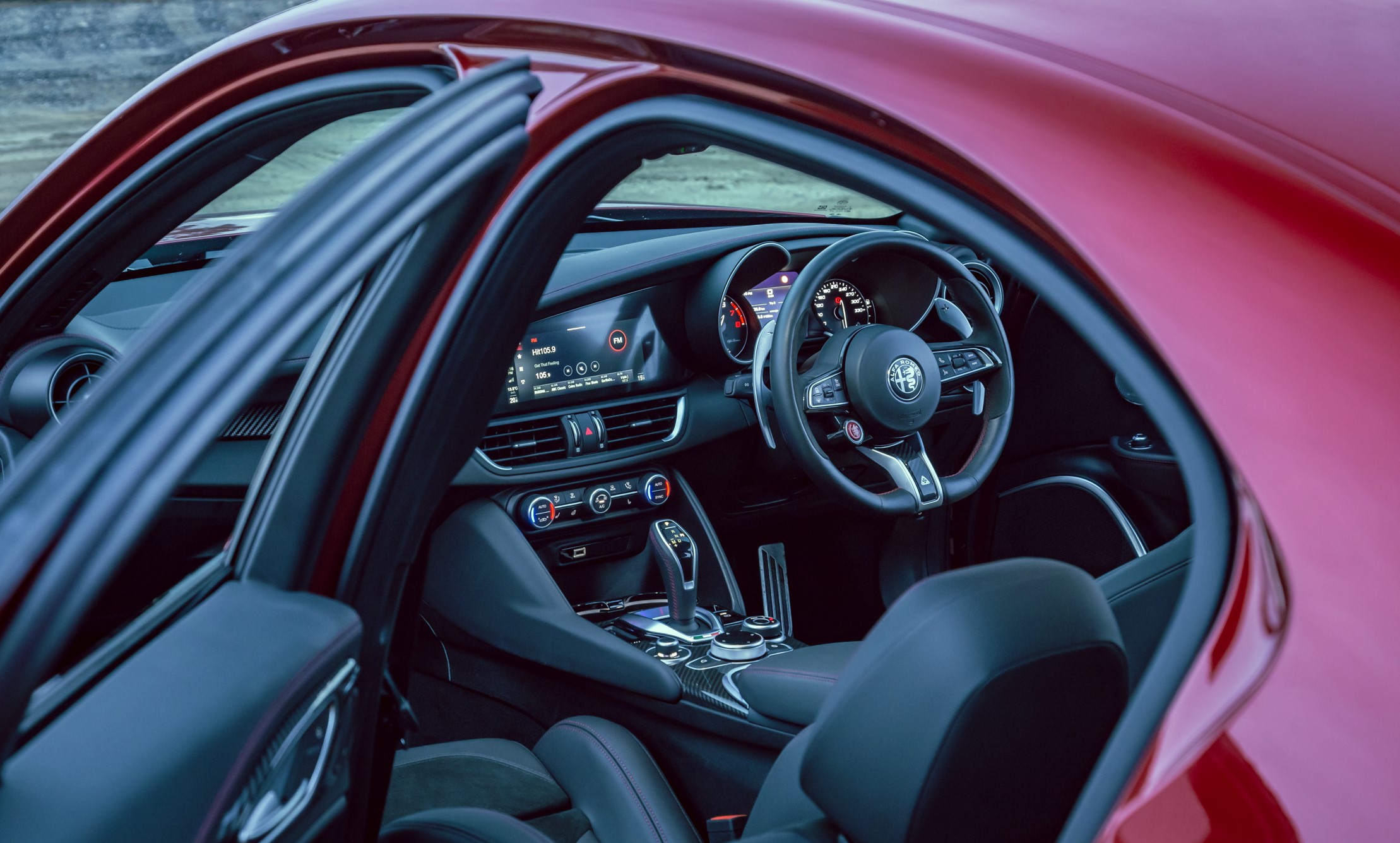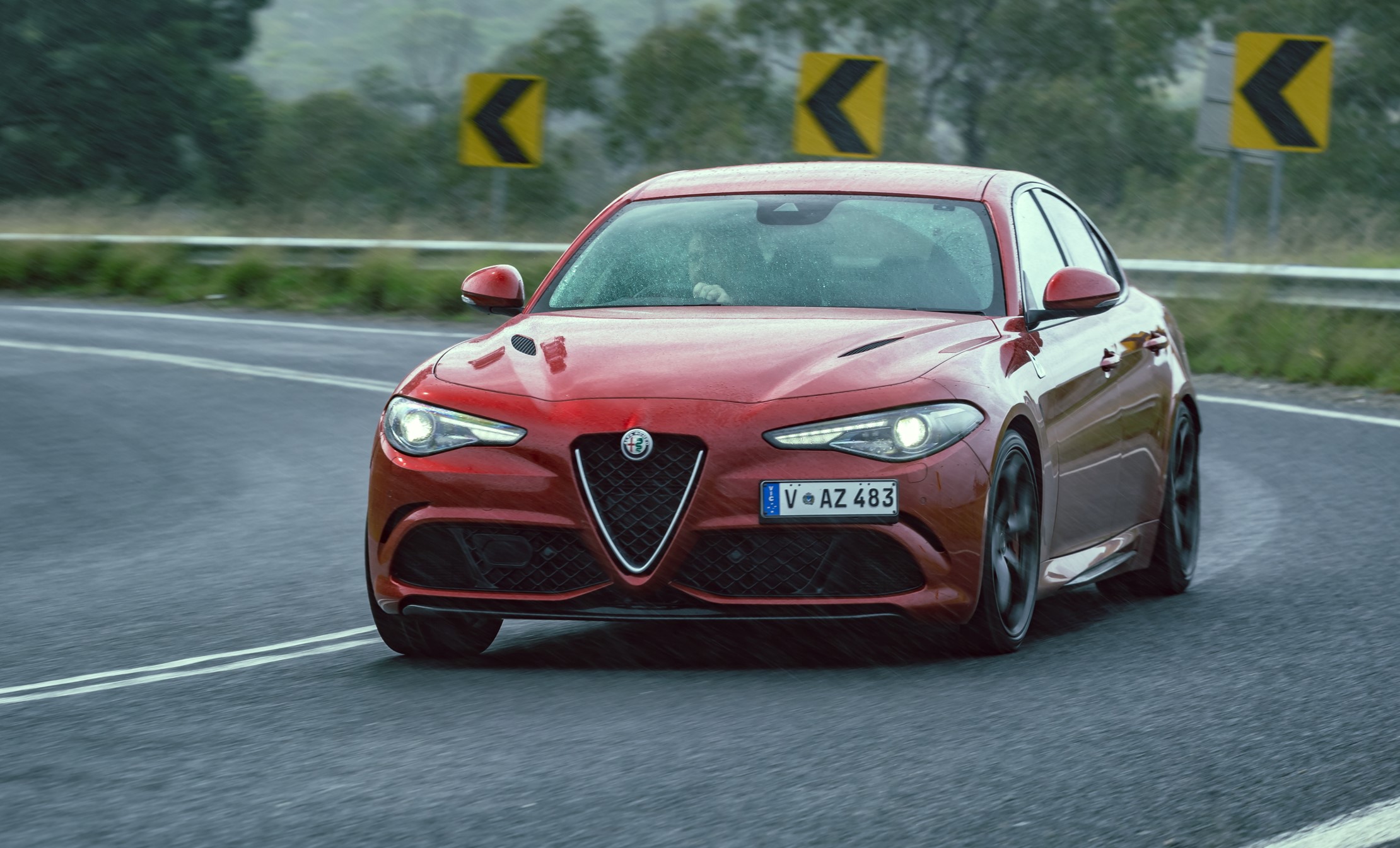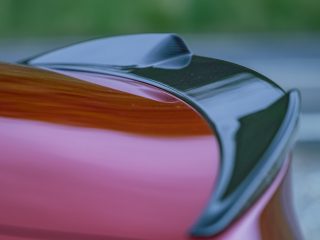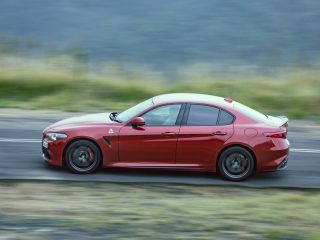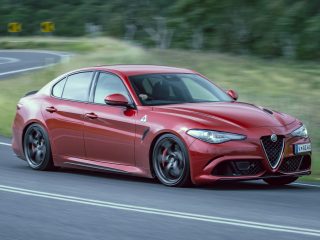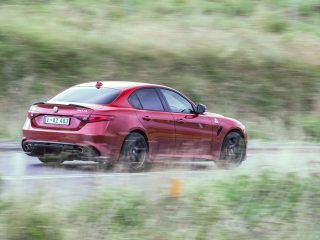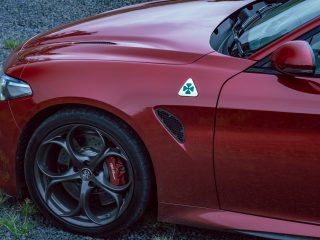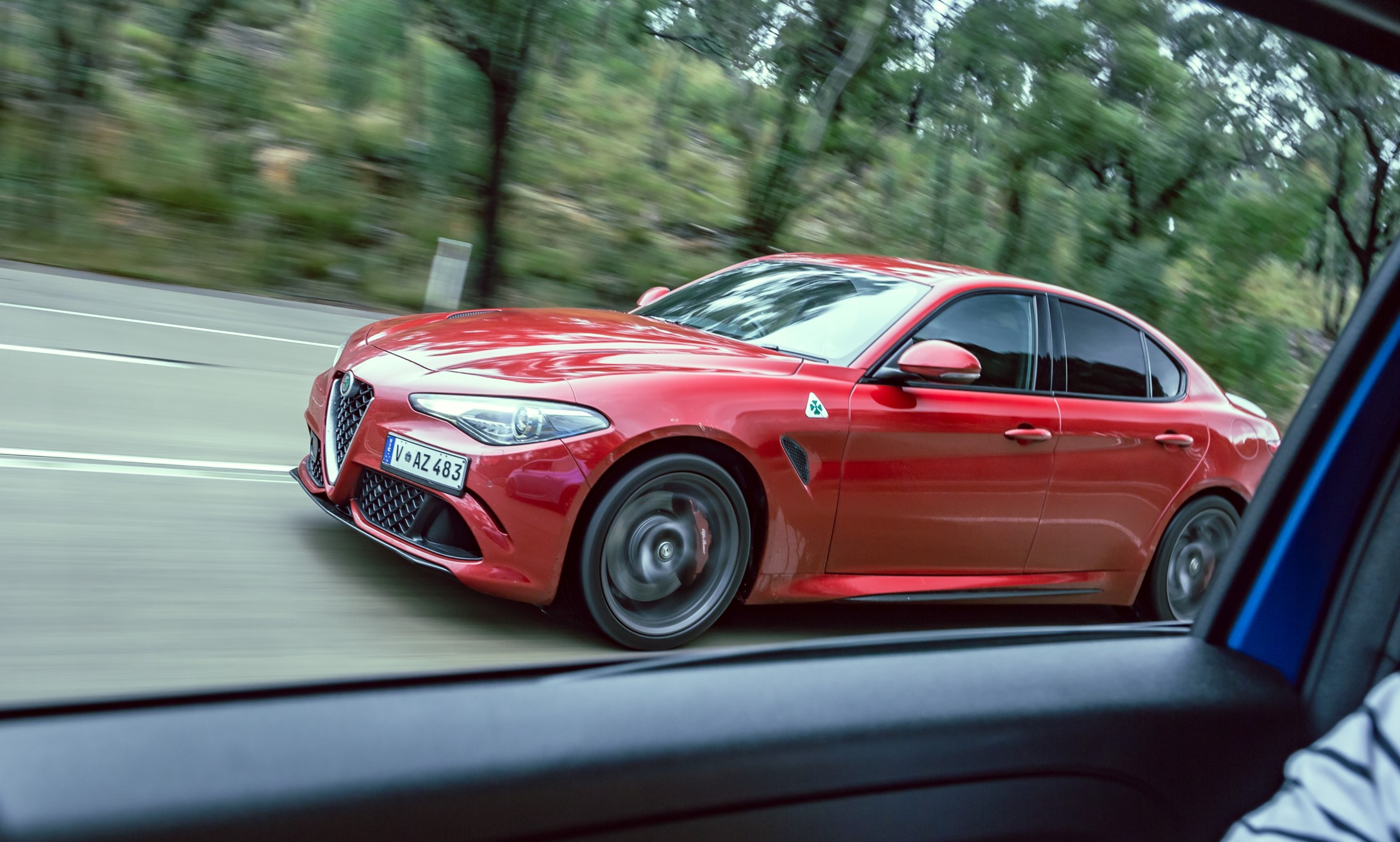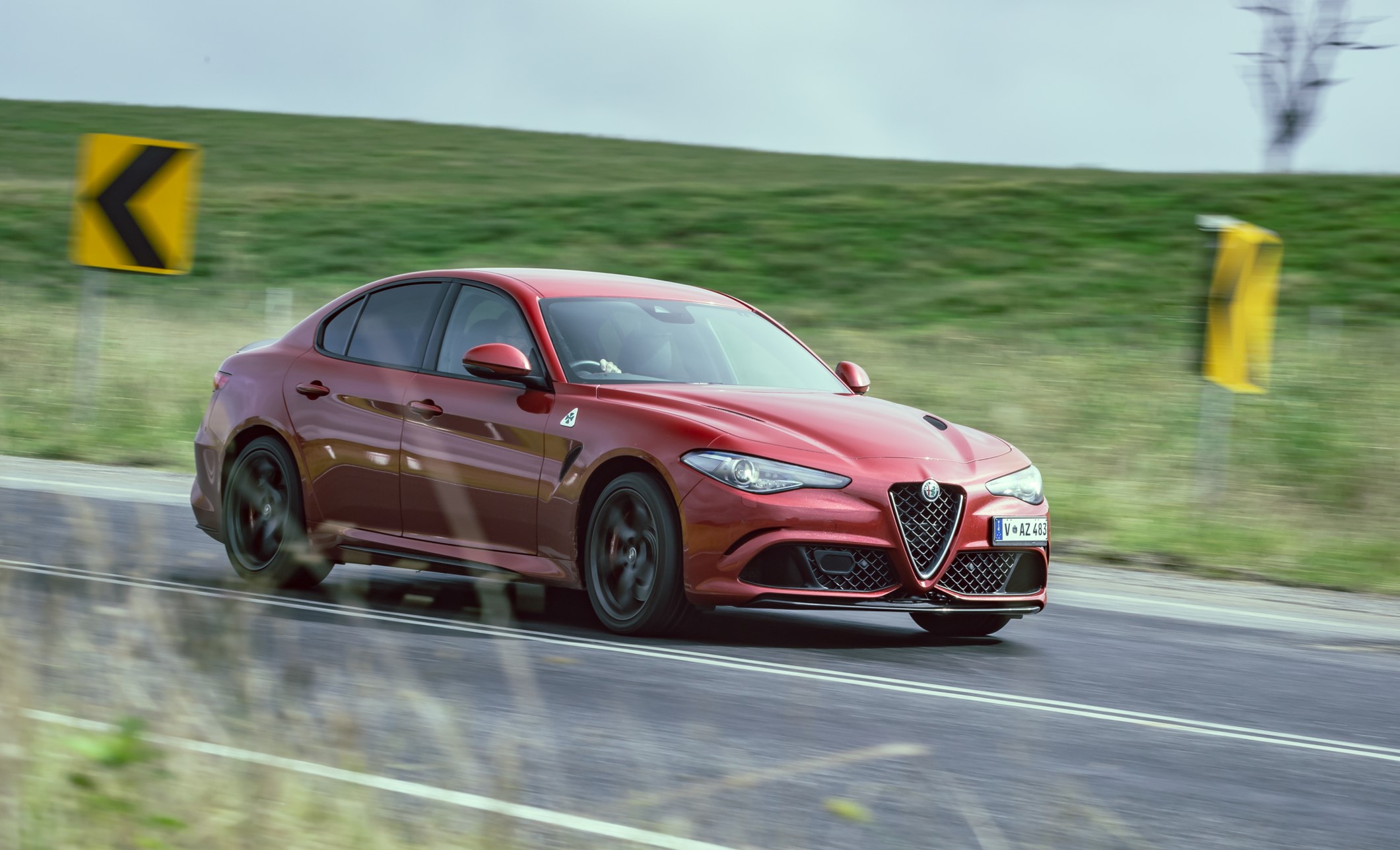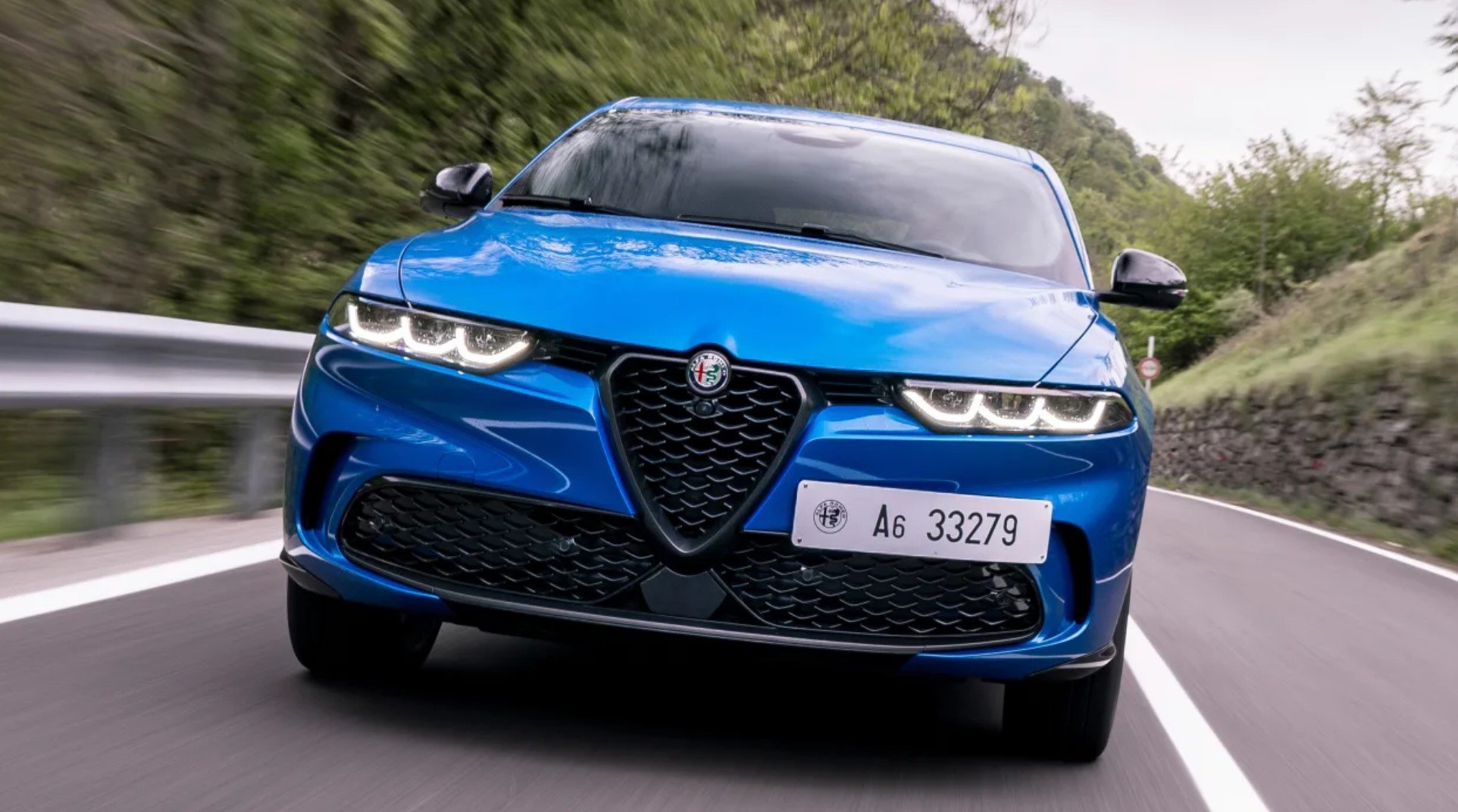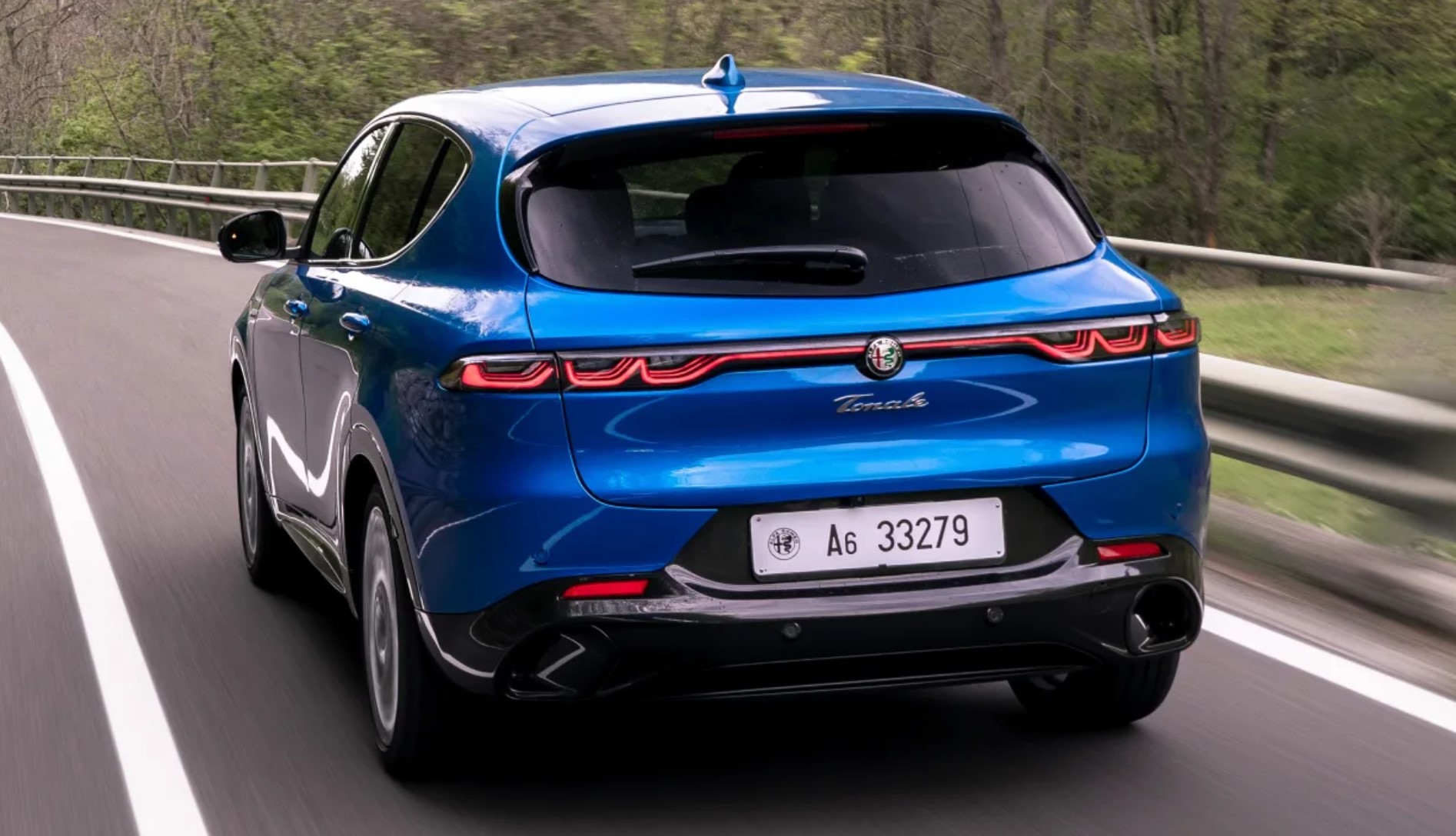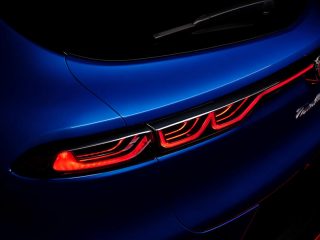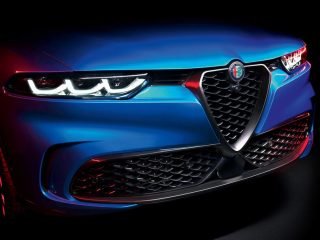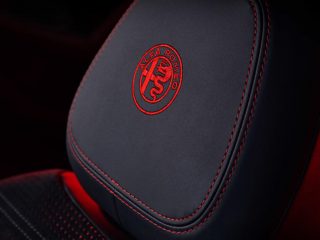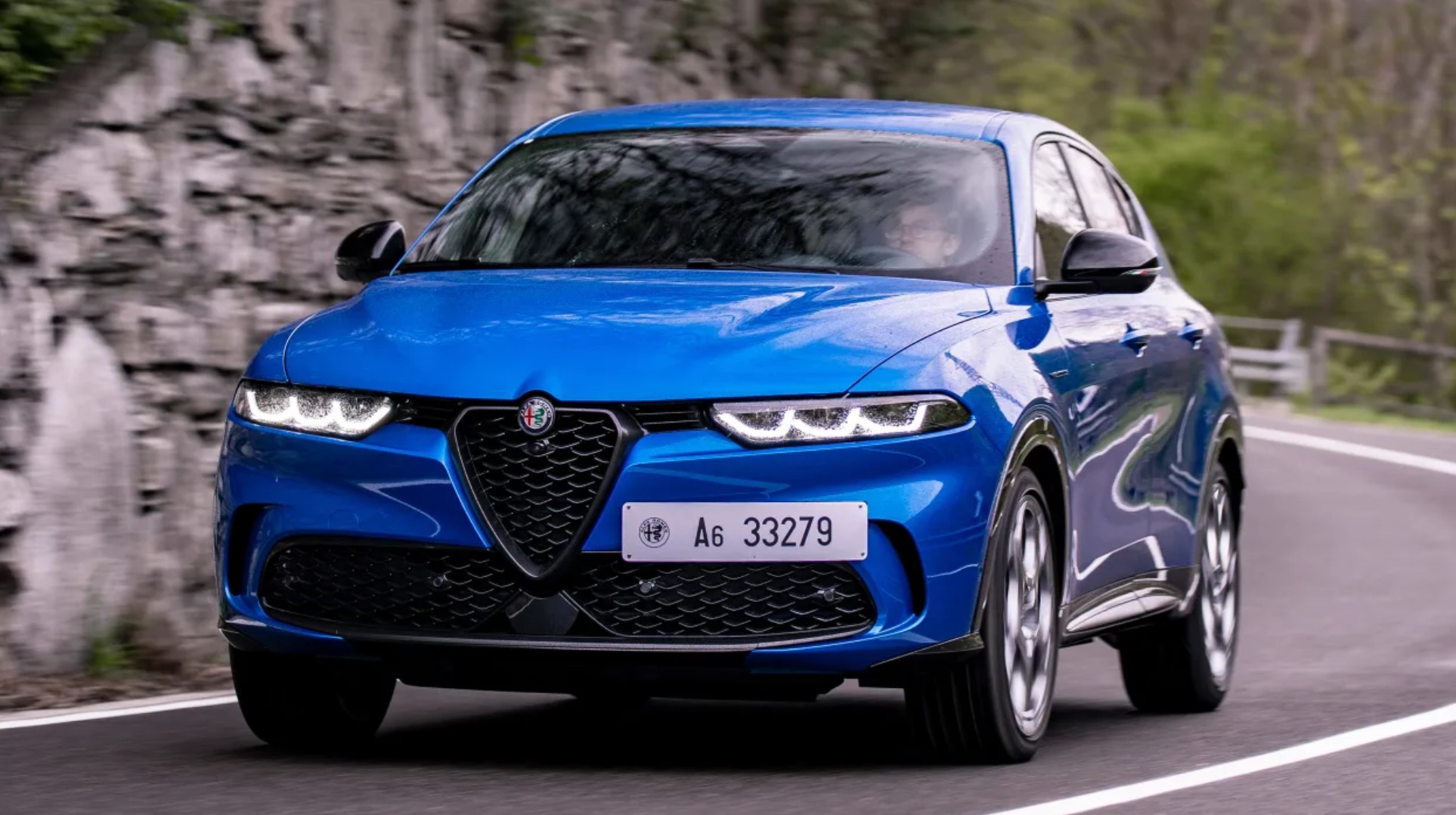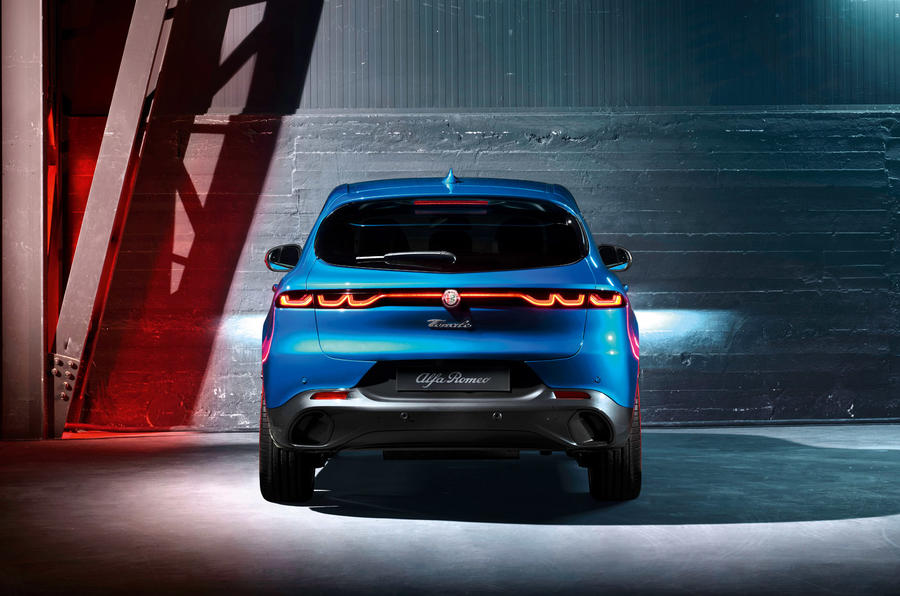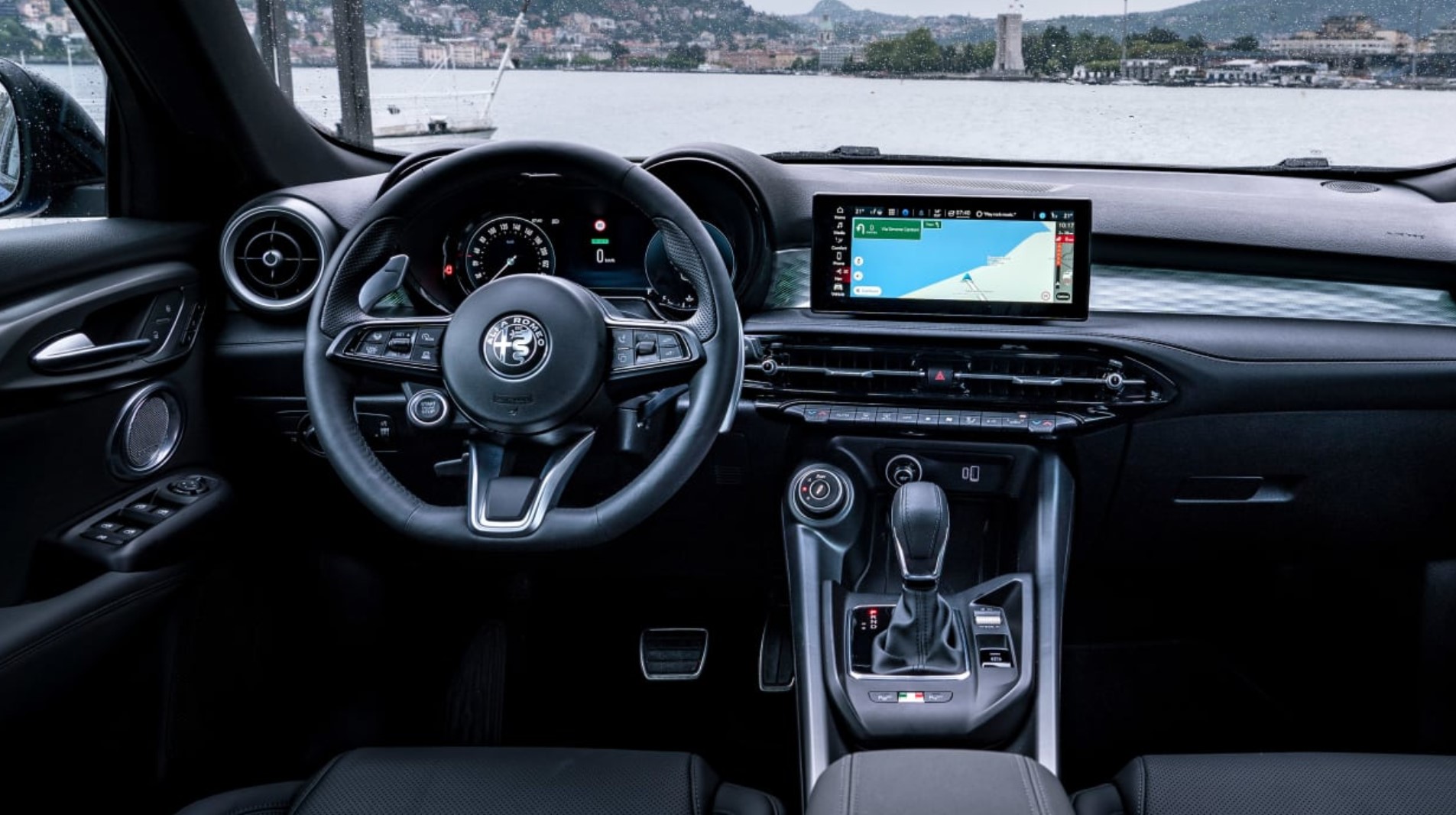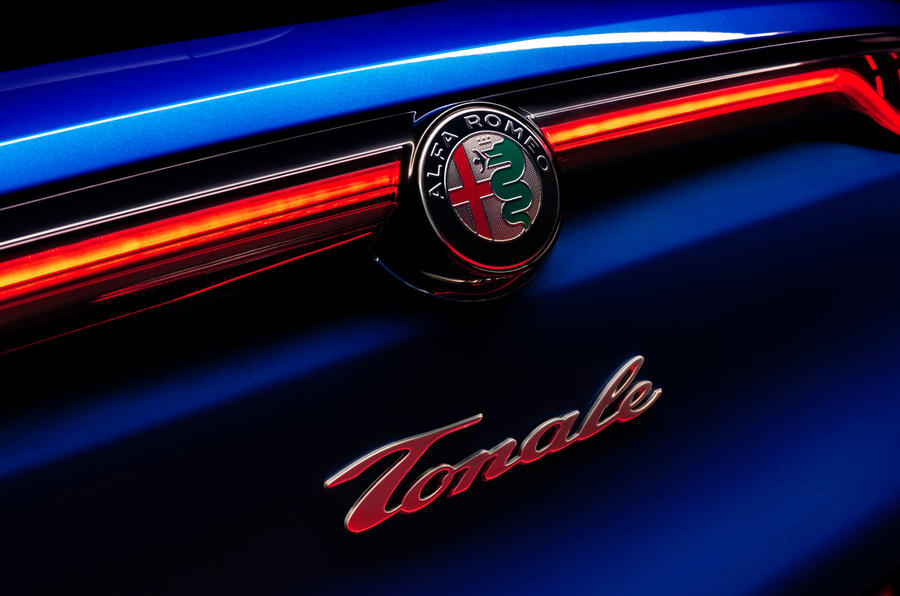What do these three initially disparate Italian cars have to do with one another? They form one of the most fun and characterful, yet versatile three-car garages currently available.
FUN FACTORY
Words by Jesse Taylor
The three-car dream garage is one that’s well known and often played by car enthusiasts. To keep the game fresh, various rules are often applied so that my garage isn’t just a rehash of the same three hardcore track cars. For us, it’s often played on Automotive Daily photo shoots while ace lens man Thomas Wielecki is making us stand on some windswept hillside in winter or baking under later afternoon summer sun while we wait for golden light. It was during one of these moments of torment when AD’s long-serving driver Justin Bedingfield suggested a new set of ground rules (which, as you’ll shortly see, have already been bent).
Justin’s idea was to form a dream garage from just a single manufacturer, but with the usual caveat that at least one car must have genuine potential to serves as a daily driver, seating four. We spent the remainder of the shoot (many, many hours in other words) dreaming up garages from a random assortment of manufacturers. When it came to Alfa Romeo, we bent the rules just a little to expand the selection to include Abarth from under the same Stellanis umbrella.
Before we truly start, full disclosure from your humble scribe. My first two cars were Fiats – an X1/9 and a 131 Superbrava fitted with full Group 4 Abarth running gear. I still own the latter and, thanks to these two wonderfully quirky cars, I’ve had a love affair with Italian cars (especially the smaller more affordable ones) for nearly 30 years.
Dollar per smile, I don’t think that there’s a more fun car on the Australian market than the Abarth 595 Competizione. It feels like a proper throwback to the days when nearly every car made in Italy – from the most humble to the most outrageous – was brimming with brio. Rose-tinted glasses may use the term ‘character’ to paper over short comings, it’s something that we crave more than perfection. All of the most memorable cars that we’ve ever tested here are probably too noisy, too difficult to get in and out of, and ride too firmly for 90 per cent of the general public. The little Abarth might look like something that you could pick up and cuddle, but its fiery character is just the thing for those seeking the thrill of driving but don’t have the mega budget to fulfil their dreams at a Porsche or Ferrari dealership.
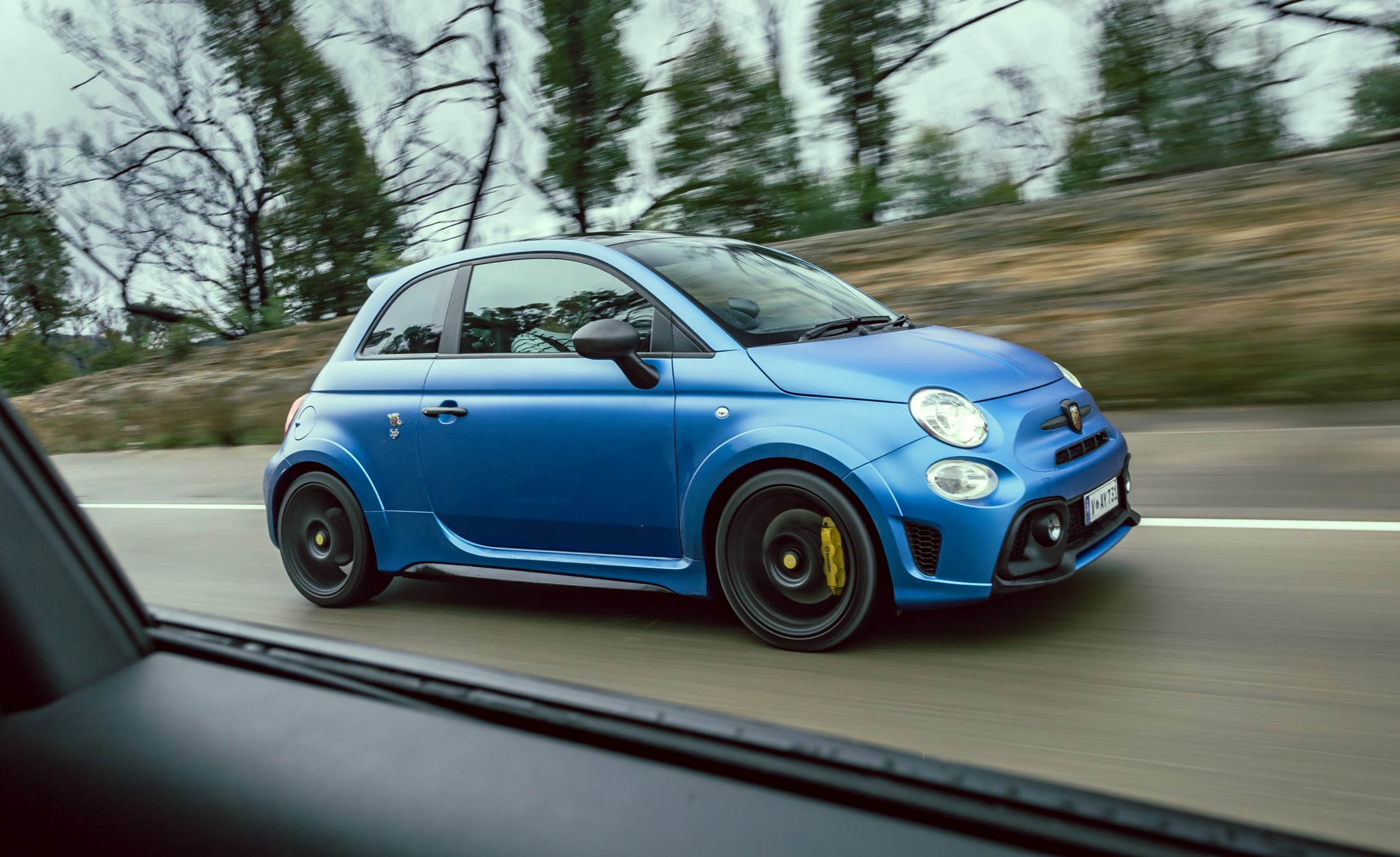 At $34,250, the 595 Competizione sits one rung down from the range-topping $44,950 695 70th Anniversario model and above the entry-level $26,990 595 and $31,450 Scorpione Oro variants. For those that want to remove any ceiling to the fun factor, two convertible variants are also offered – the $29,990 595 and the $37,250 Competitzione. As an aside, a few years ago I ran a convertible 595 at around the time we got our labradoodle puppy. Within six weeks he was enormous (despite coming with an expensive spec sheet that suggested he was a ‘medium’) and would often poke his gigantic fluffy head out of the open roof to the delight of all around.
At $34,250, the 595 Competizione sits one rung down from the range-topping $44,950 695 70th Anniversario model and above the entry-level $26,990 595 and $31,450 Scorpione Oro variants. For those that want to remove any ceiling to the fun factor, two convertible variants are also offered – the $29,990 595 and the $37,250 Competitzione. As an aside, a few years ago I ran a convertible 595 at around the time we got our labradoodle puppy. Within six weeks he was enormous (despite coming with an expensive spec sheet that suggested he was a ‘medium’) and would often poke his gigantic fluffy head out of the open roof to the delight of all around.
There is something adorably puppy-like about the 595 Competizione. As soon as you fire the 1.4-litre turbocharged four-cylinder engine on the key, a big-hearted sense of fun erupts and doesn’t settle until you’ve rotated the key back to the left.
Under the tiny bonnet you’ll find the familiar 1398cc turbochagred four-cylinder engine that produces an entertaining 132kW at 5500rpm and a stout 250Nm at 3000 revs. There’s a bit of lag down low (it’s a fairly sizeable Garrett turbo that needs spooling up), but by 3000rpm the engine is hauling, and by 5000rpm, the Monza exhaust is making all sorts of fruity noises.
In today’s world of enormous power outputs, the Abarth’s 132kW might seem undernourished but when coupled to the manual gearbox of our test example, the 595 Competizione feels genuinely fast and exciting across the ground. That you can drive it hard and be pretty close to the letter of the law and social acceptability is a real boon these days when a toe twitch in a mega car is enough for you to make the evening news. The gearbox may only have five ratios, but the very fact that it’s a manual is worth celebrating. The shift is positive and the pedals are well spaced for heel-and-toe downshifts. Because there are only five ratios, you’re asked to work through the gears more often and it’s terrific fun to keep that ever eager little engine on the boil by running it towards redline and firing in any upshift.
There’s almost no end of grip from the 205/40 tyres mounted on the 17-inch alloys and the Abarth can be hustled at indecent pace. It claims a 6.7-second sprint to 100km/h and a top speed of 225km/h, the former very believable and the latter more than enough for something so tiny. I dare you not to laugh like a drain at the Abarth’s ability to pick apart a tight road. I’d also like its chances chasing bigging-hitting and theoretically faster performance cars at a track day.
2022 Abarth 595 Competizione
Motor 1398cc turbocharged petrol four-cylinder Power 132kW @ 5500rpm Torque 250Nm @ 3000rpm Transmission Manual five-speed, front-wheel drive Steering Rack and pinion, electrically-assisted Suspension McPherson strut front, torsion beam with anti-roll bar rear Brakes 305mm front, 240mm rear discs, ABS Weight 1035kg Top speed 225kph 0-100kph 6.7sec
ALFA ROMEO STELVIO
An Alfa sports car on stilts, the Stelvio retains SUV practicality while offering layers of performance car character to play with.
T
he second entry in our Stellanis dream garage sits at the opposite end of the size and power spectrum to the diminutive Abarth 595 Competizione.
Full-sized performance SUVs and Automotive Daily’s performance editor haven’t always seen eye to eye. There are only a handful exceptions to this indifference (sometimes hostility) to the genre – Porsche Cayenne, Aston Martin DBX and the Alfa Romeo Stelvio Quadrifoglio. Unlike so many big-hitting SUVs, the Stelvio is shot through with character and a sense of fun.
The Stelvio immediately reveals a layer of its character when you press the start button. There isn’t the boom crash opera of a Mercedes-AMG V8 firing up from cold, but the Alfa’s twin-turbo V6 sounds potent, idling with a deep loping beat but with an underlying urgency. Of course, we’re familiar with the V6 from the great work it does in the Giulia Quadrifoglio super sedan but it’s worth a quick refresher.
Both the Stelvio and Giulia Quadrifoglio V6 uses a 90-degree included angle, which, as those who know about primary balance will note, is an odd angle for a V6. But that angle begins to make sense when Alfa Romeo tells you that the 2891cc V6 is a development of the 3855cc twin-turbocharged V8 found under the bonnet of Ferrari’s Portofino. Beyond the shared vee-angle, both the Ferrari V8 and Alfa Romeo V6 feature an 86.5mm bore and 82mm stroke. The Stelvio’s V6 is literally a Ferrari V8 with two cylinders shaved off.
It’s a storming engine and in the case of the Stelvio, its 375kW, 600Nm outputs are harnessed by a clever all-wheel-drive system.
Having undergone a subtle refresh in 2021, most of the mechanical hardpoints were left alone. Instead, new bits of interior trim and an update to the digital interfaces aimed to sharpen things right up. Has its appeal diminished? Not a bit of it, as while a Porsche Macan GTS might be more rounded, and a Jaguar F-Pace SVR more exuberant, the Stelvio remains the only truly engaging SUV, and one you’d happily drive just for the fun of it.
From the get-go it feels light and responsive and benefits from the quick and direct steering similar to the Giulia Quadrifoglio’s, giving it a level of response that’s unmatched for a tallish SUV weighing the wrong side of 1800kg. The steering’s interaction with the wheels is backed up by the Quad’s intense geometry set-up, which like the most aggressive sports and supercars compromises on day-to-day useability for the sake of front-end grip and response. The steering doesn’t unnaturally amplify the axle’s capability like it sometimes can in some rivals, instead it merely gives you more access to more grip, more of the time.
This isn’t harmed by the front axle’s need to put power down either, as the steering remains largely free of any corruption. It just feels like the Stelvio is rear-wheel drive with an unnatural amount of traction.
Overall, the 2.9-litre V6 loses none of its brio with the extra weight and driven wheels attached to it. Left in automatic mode the ZF delivers each ratio with an instant, seamless shift, but as with the Giulia, you’ll want to use the beautiful aluminium paddles fitted to the steering column and change gear yourself. Unless you’re in Race mode, the gearbox doesn’t change as you approach a corner, instead waiting for you to get on the power before kicking down.
You’ll also want to select Dynamic or Race mode on the Pro-DNA system, even if you’re using manual mode, because not only do the throttle’s response and the ZF’s shifts sharpen up, but the ESP loosens its reins, too (it switches off altogether in Race mode) and the exhaust valves open to increase the volume. The result is rabid performance and an evocative soundtrack as the Stelvio bursts from corner to corner, devouring straights at a rate Audi RS, BMW M and Mercedes-AMG sedan and coupe owners will recognise.
The Pro-DNA settings also alter the dampers’ stiffness. On our roads there isn’t the same noticeable change in the ride between the softest setting and the intermediate level that you get when you select Dynamic mode – it stays firm and tense; much less forgiving than the Giulia Quadrifoglio, but still not uncomfortable. Although the ride feels much the same between the two modes, body roll and pitch is far better contained in Dynamic and, even on the winter tyres it felt sharp and direct. In Race, the dampers felt too firm as bumps made the car bounce and feel unsettled. However, the damper button in the middle of the Pro-DNA dial allows you to tone down the dampers by one setting, so in Race mode you can select the Dynamic dampers.
It’s this combination – Race for the lack of driver assistance systems, the engine noise and the fastest gearchanges, and Dynamic for the dampers – that works perfectly on Australian roads. The Stelvio Quadrifoglio feels so natural to be driven quickly that you feel completely confident attacking a B-road with no stability control. Yes, the car will oversteer if the back end isn’t loaded up, but the steering is quick, allowing you to easily apply whatever corrective lock is necessary, so if you do encounter a slide you can easily correct it.
So few performance SUVs offer anything like the engagement of the Stelvio Quadrifolgio and those that do are more expensive – in some cases by at least a factor of two.
2022 Alfa Romeo Stelvio Quadrifoglio
Motor 2891cc petrol twin turbocharge V6 Power 375kW @ 6500rpm Torque 600Nm @ 2500-5000rpm Transmission Automatic eight-speed, rear-wheel drive Steering Rack and pinion, electrically-assisted Suspension Double wishbone front, multi-link rear Brakes 390mm front, 360mm rear discs, ABS Weight 1830kg Top speed 283kph 0-100kph 3.9sec
ALFA ROMEO GIULIA
It was designed to take on the BMW M3, but stole our hearts along the way – the Alfa Romeo Giulia Quadrifoglio is masterpiece.
We’ve been huge fans of the Giulia since the first time we were first embraced by its driver’s seat. Actually, our infatuation with the Giulia Quadrifoglio began well before we first drove it, when the first images were revealed. Just look at it. Can you name a better-looking sedan on the market today? I’ll wait…
Automotive Daily’s love affair with the Giulia Quadrifoglio was practically guaranteed given that it was engineered by the same person who developed one of our all-time favourite cars. After delivering the Ferrari 599 GTB, F12 Berlinetta and legendary 458 Speciale, Roberto Fedeli led the team that brought us the Giulia and Stelvio Quadrifoglio, and it’s obvious that the Alfa Romeo models have been crafted with the same level of passion and focus on the driver as the legendary Ferrari.
The starter button is positioned on the steering wheel while two long aluminium paddles, that follow the curve of the rim, are actually mounted on the column. Both feel very Ferrari-esque indeed.
Another aspect of the Alfa that feels oh-so Ferrari is the steering. Just metres down a road you become aware that the Giulia has a very fast steering rack indeed, more than a little reminiscent of that found in the Ferrari 458 and 488, no less.
The perfect seating position and super fast steering instil a confidence in you that you could deal, react and drive through just about any situation with supreme accuracy; the conviction that you’d be able to tame a wild and unruly rear-wheel drive turbocharged car with ease.
But the Quadrifoglio isn’t the rabid, spiky animal its numbers might suggest. Don’t get us wrong, it’s certainly fast, but the way the performance is delivered from its 2.9-litre V6 is progressive and linear. The engine is muscular from low down and the car’s speed builds rapidly, but in perfect conjunction with the revs. There’s never that heart in your mouth moment when a huge wave of torque takes over, the revs spike and the car squirms in protest. Instead, it just powers forward in the manner you dictate.
There’s also a suppleness to the chassis which feels odd for a car with such sporting pretensions. The ride is rounded and plush, unlike the firm ride the Alfa’s rivals’ exhibit. It’s only as you being to really push the Giulia that softer chassis feels slightly lacking in body control, and a touch too much roll is apparent. But the Giulia’s DNA drive settings allow you to stiffen up the chassis as well as sharpening the throttle, adding weight to the steering and making the exhaust a bit louder. There are four DNA driving modes selected by a small rotary knob on the transmission tunnel. Advanced Efficiency (A) is the most fuel efficient and allows one bank of the V6’s cylinders to shut down.
Peel off onto quiet B-roads and the talent pool obviously runs deep. There aren’t many modern performance cars that feel as lightfooted as this. Even at a moderate pace it seems to dance around the road, responding keenly to economical movements of the steering and throttle, getting maximum benefit from minimal inputs. Quick steering can feel edgy in some cars, but the Giulia’s chassis seems perfectly in tune with the tight two turns lock-to-lock ratio, so it feels instantly natural, with just enough feedback to reassure the fingertips.
Next up is Natural (N), but Dynamic (D) and Race (yes, R) are where it gets interesting as the throttle, exhaust, gearshift, suspension and steering all ramp up the involvement.
The heavier steering is useful as it helps to slow your inputs and keep steering wheel movement to a minimum. The exhaust sounds bassier too, and you get either a satisfying crack at every upshift.
The biggest change is to the chassis, however. Dynamic firms up the dampers, but the car still feels compliant. Should you wish to have the noise, steering and throttle of Dynamic with the softest suspension, a button in the middle of the DNA dial allows you to relax the dampers.
Race mode is firmer still, but just as in Dynamic you can back the dampers off to a softer setting; not fully soft, but the same setting as the default in Dynamic. No matter which mode you’re in though, the suspension never feels unbearably stiff. Only the very bumpiest of roads makes Race feel less than ideal, but the slightly tighter body control is still preferred by some of the Automotive Daily team. Others prefer the more compliant modes, as it never really feels wayward or unrestrained. Either way, there’s a setting to suit everyone.
Race mode also disables the ESC and traction control – it’s the only way to deactivate the safety systems. This might suggest, as well as its name, that Race is a no-go on the road. That is not the case. The chassis and tyres provide so much grip you can still use a lot of throttle in the dry, while the engine’s predictable delivery means it’s easy to judge just how much throttle is necessary to maintain traction. If you’re more brutal with your right foot the tyres will relinquish their hold on the tarmac, but the fast steering means you can instantly react with the exact amount of corrective lock and control the car immediately.
Everything about the way the Giulia behaves is transparent, readable and dependable. As ludicrous as it might seem, the 375kW, turbocharged, rear-wheel drive Giulia is incredibly approachable.
2022 Alfa Romeo Giulia Quadrifoglio
Motor 2891cc petrol twin turbocharge V6 Power 375kW @ 6500rpm Torque 600Nm @ 2500-5000rpm Transmission Automatic eight-speed, rear-wheel drive Steering Rack and pinion, electrically-assisted Suspension Double wishbone front, multi-link rear Brakes 360mm front, 330mm rear discs, ABS Weight 1620kg Top speed 307kph 0-100kph 3.9sec
…..A new era
ALFA ROMEO TONALE
Alfa Romeo’s all-new Tonale SUV is set for Australian release in early 2023.
This new Alfa Romeo compact SUV, a rival to the Audi Q3 and Volvo XC40, is not only the first model to be launched in this new Stellantis era for Alfa Romeo but also its first foray into electrification, which will rapidly take centre stage for the brand. From 2027, Alfa will launch only electric cars. Following the Tonale’s introduction, the brand will launch a new car every year until 2030, according to CEO Jean-Philippe Imparato, who previously ran Peugeot.
Alfa’s first fully electric model, a small SUV understood to be called the Brennero, will arrive in 2025, while a GTV-badged model, rumoured to be an electric four-door coupé, is also expected in the line-up.
Imparato called the entry-level SUV a “cool car” and confirmed the company is currently considering designs for the model.
On a future GTV in the vein of a four-door coupé, Imparato said that so long as the inside is spacious, as electric architectures typically allow, the model is possible. “Next year, we will show a concept that is not very far from the GTV, with enough roominess to fit customer expectations, from 2025 to 2027,” he said.
The Tonale, like the Stelvio, is named after a famous Italian mountain pass, albeit a lower one than that of its bigger SUV sibling.
Although it sits on a platform developed by ex- parent company Fiat Chrysler Automobiles (FCA), the only commonality is the central floor, and Alfa Romeo has already confirmed the platform is set up for a fully electric Tonale if there is demand for it. At 4.53m long, 1.84m wide and 1.6m tall, the car is nearly identical in size to the Q3, albeit slightly longer.
The Tonale sets a benchmark for the segment for driving dynamics, Alfa has claimed. It uses MacPherson suspension with frequency-selective damping, achieves 50:50 weight distribution and adopts a brake-by-wire system that promises “instantaneous response”, while the steering is said to be the most direct in the segment.
For now, the core Tonale range is made up of two electrified variants: a hybrid powertrain with a choice of 95kW or 118kW and a plug-in hybrid – at this stage only the 118kW hybrid is confirmed for Australia, though the brand has suggested that it will constantly evaluate the market.
Both hybrid variants use a four-cylinder 1.5-litre petrol engine paired with a seven-speed dual-clutch automatic gearbox and a 48V electric motor, which is active in start-up, low-speed driving and cruising in electric mode.
he most powerful model in the line-up is the plug-in hybrid, which pairs with a 1.3-litre turbo petrol engine providing drive to the front wheels, with an electric motor connected to the rears.
Using a 15.5kWh battery and delivering a total output of 202kW, the set-up achieves 0-100km/h in 6.2 seconds. The all-wheel-drive model is expected to offer between 60 and 80 kilometres of electric-only range.
Imparato considers software to be at the forefront of Alfa Romeo’s reinvention and the Tonale has all of the technology you would expect in a premium SUV: a digital 12.3-inch screen, plus a 10.25-inch touchscreen with a customisable home screen, Apple CarPlay and Android Auto compatibility, over-the-air updates and a host
of driver assistance systems, including adaptive cruise control and traffic-jam assistance.
It’s also the first car in the world to have a non- fungible token (NFT), which links a car to a digital certificate based on blockchain technology. With the customer’s consent, it creates a confidential and non-modifiable record of the main stages of a car’s life, which acts as a guarantee that the car has been properly maintained, helping to improve residual value.
The Tonale is intended for a “young, metropolitan and dynamic customer”, said Alfa Romeo, and features numerous nods to the brand’s heritage. These include the so-called ‘GT Line’, which runs from the rear to the headlights, as seen on the 8C Competizione, and the 3+3 headlights, which reflect those of the 1989 SZ. The front also features the iconic ‘Trilobo’ nose and distinctive ‘Scudetto’ shield. The alloy wheels are a modern take on the telephone-dial design that began in the 1960s on models such as the 33 Stradale.
The Tonale might represent a new chapter for Alfa Romeo, but that it draws so successfully on the brand’s heritage ensures that it will slot into the line-up like a model that’s always been here.
Register your interest at alfaromeo.com.au


